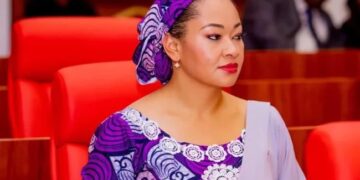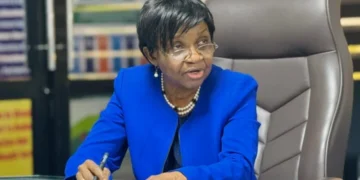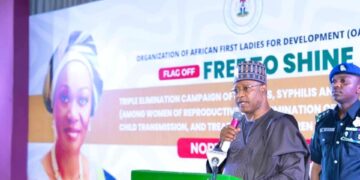By Eshiorameh Sebastian, Abuja
The Presidency has faulted recent media reports claiming that President Bola Tinubu is seeking a $21 billion loan, describing the coverage as misleading and lacking proper economic context.
In a rebuke posted on his social media handle, Temitope Ajayi, Senior Special Assistant to the President on Media and Publicity, slammed journalists for misrepresenting a borrowing plan submitted to the National Assembly as an immediate loan request.
The text titled: ‘On $21b dollars loan, the Presidency said it was very “obvious that the journalists covering the National Assembly need some basic training on how to report the economy, economic data and other financial matters, especially in situations where analysing and interpreting numbers become imperative”.
The statement clarified that the document in question was a borrowing plan for 2025-2026, outlining potential loans for federal and state projects—not an approved or finalized loan.
“A borrowing plan doesn’t amount to taking $21 billion loan. It only shows a plan of what can be borrowed and where the loans will come from for specific projects that are important to the Federal and State governments. The plan also shows what will be borrowed by the FG in 2025”, the text read.
The Presidency explained that fiscal responsibility requires transparency in presenting borrowing plans to lawmakers, even if loans are not eventually taken. It also noted that any approved loans would be drawn down over 5-6 years, tied to project milestones.
According to Ajayi, a plan to borrow money does not mean loan will be taken at the end of it all. Even when specific loans are eventually taken the draw down has project timelines and milestones that will take between 5-6 years. “The loan that the FG should take in first quarter 2025 has not even been taken up till now and may be rolled into second half of the year.
“Instead of the news reports to be nuanced and contextual virtually every news outlet went to town that Tinubu wants to borrow $21billion dollars and all manners of public affairs analysts and ‘experts’ have been running commentaries on the basis of misrepresentation of facts”, Ajayi lamented.
He concluded by urging journalists to “do better by presenting information accurately and factually to the public”.
The response from the Presidency followed media reports, that President Tinubu requested Senate approval for a 2025–2026 External Borrowing Plan totaling $21.5 billion, €2.2 billion, ¥15 billion, and a €65 million grant to fund critical infrastructure, agriculture, health, education, water supply, and job creation, citing Nigeria’s financial constraints and infrastructure gaps.
In a letter read by Senate President Godswill Akpabio, Tinubu assured judicious use of the loans across all 36 states and the FCT to boost employment, reduce poverty, and enhance food security. Additionally, he sought approval for a N757.9 billion bond to settle pension liabilities and a €2 billion domestic bond for key sector investments. All requests were referred to the Senate Committee on Local and Foreign Debts for further review within two week.
Meanwhile a statement issued by the Federal Ministry of Finance on Tuesday, May 27, 2025 has clarified that the plan was a strategic, forward-looking framework, not an immediate loan request—aligned with the Fiscal Responsibility Act (2007) and Debt Management Office (DMO) Act (2003). It outlined potential borrowing for federal and state governments, detailing project-specific loans (e.g., power grids, irrigation, security, and infrastructure) with multi-year drawdowns (5-7 years) from concessional lenders like the World Bank and AfDB. The ministry stresses that the plan does not automatically increase Nigeria’s debt burden, as actual borrowing is tied to annual budgets and project milestones.
The second part of the statement defends the government’s debt sustainability strategy, noting improvements in debt-to-revenue ratios and an end to inflationary financing practices. It highlights expected revenue boosts from NNPC and tax reforms, arguing that borrowing is growth-focused—targeting infrastructure, energy, and agriculture to spur private investment. The ministry reassures the public of fiscal discipline, transparency, and accountability, inviting constructive oversight to ensure borrowed funds drive long-term economic stability. Ultimately, the statement aims to correct misconceptions, reassure stakeholders, and justify borrowing as a tool for inclusive development.
Full Statement Below:
Federal Ministry ofFinance, Abuja Press Release Re: Nigeria’s External Borrowing Plan for 2024-2026 On May 27. 2025, the President of the Federal Republic of Nigeria, His Excellency Bola Ahmed Tinubu, GCFR, formally requested the approval of the z024- 2o26 External Borrowing Rolling Plan from the National Assembly.
This press release provides context and clarification on the purpose and significance of the request. The proposed Borrowing Rolling Plan is an essential component of the Medium-Term Expenditure Framework (MTEF) in accordance with both the Fiscal Responsibility Act 2007 and the DMO Act 2003. The Planc The Plan outlines the external borrowing ramework for both the federal and sub-national governments over a three-year period, accompanied by five detailed appendices on the projects, terms and conditions, implementation period, ete. By adopting a structured, forward-looking approach, the plan facilitates comprehensive financial planning and avoids the inefficiencies ofad hoc or reactive borrowing practices. This strategic method enhances Nigeria’s ability to imnplement effective fiscal policies and mobilize development resources. The borrowing plan does not equate to actual borrowing for the period. The actual borrowing for each year is contained in the annual budget. In 2025, the external borrowing component is US SL23 billion, and it has not yet been drawn. This is planned for H2 2025. Also, the plan is for both federal and several state governments across numerous geopolitical zones including Abia, Bauchi, Borno, Gombe, Kaduna, Lagos, Niger, Oyo, Sokoto, and Yobe States. Importantly, it should be noted that the Borrowing Rolling Plan does not equate to an automatic increase in the nation’s debt burden. The nature of the rolling plan means that borrowings are split over the period of the projects. For example, a large proportion of projects in the 2024.- 2026 rolling plan have multi-year draw downs of between 5-7 years which are project-tied loans. These projects cut across critical sectors of the economy, including power grids and transmission lines, irrigation for improving food security, fibre optics nerwork across the country, fighter jets for security, and rail and road infrastructure. The majority of the proposed be ed borrowing will be sourced from Nigeria’s development partners, including the World Bank, African Development Bank, French Development Agency, European Investment Bank, JICA, China EximBank, and the Islamic Development Bank. These institutions offer concessional financing with favourable terms and long repayment periods, thereby supporting Nigeria’s development objectives sustainably. The government seeks to reiterate that the debt service to revenue ratio has started decreasing from its peak of over go% in 2023. The government has ended the distortionary and inflationary ways and means. There are significant revenue expectations from the Nigeria National Petroleum Corporation (NNPC), and technology-enabled monitoring and collection of surpluses from Government Owned Enterprises and revenue-generating ministries, departments, and agencies, including legacy outstanding dues. Having achieved a fair degree of macroeconomic stabilization, the overarching goal of the Federal Government is to pivot the economy onto a path of rapid, sustained, and inclusive economic growth. Achieving this vision requires substantial investment in critical sectors such as transportation, energy, infrastructure, and agriculture. These investments will lay the groundwork for long-term economic diversification and encourage private sector participation. Our debt strategy is therefore guided not solely by the size of our obligations, but by the utility, sustainability, and economic returns of the borrowing. Ensuring that all borrowed funds are efficiently utilized and directed toward growth-enhancing projects remains a top priority. In conclusion, the government remains committed to keeping borrowing within manageable and sustainable limits in accordance with the DMO Debt Sustainability Framework. The ongoing tax reform agenda, and other revenue initiatives, will further improve revenue generation and prudent financial management. We reaffirm our dedication to fiscal discipline, transparency, and accountability. Constructive public engagement and legislative oversight are vital components of our journey toward long-term economic stability and inclusive national prosperity. Signed, Mohammed Manga, FCAI Director, Information and Public Relations May 27, 2025












































Discussion about this post